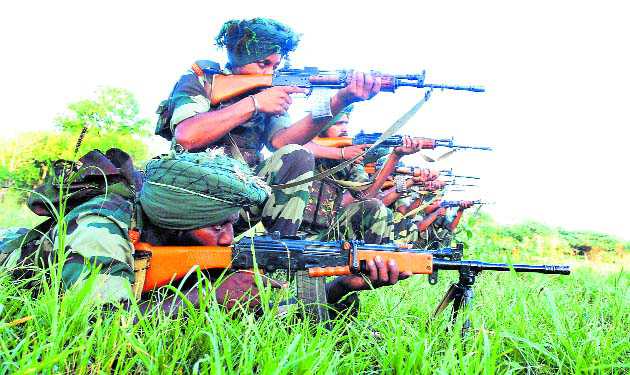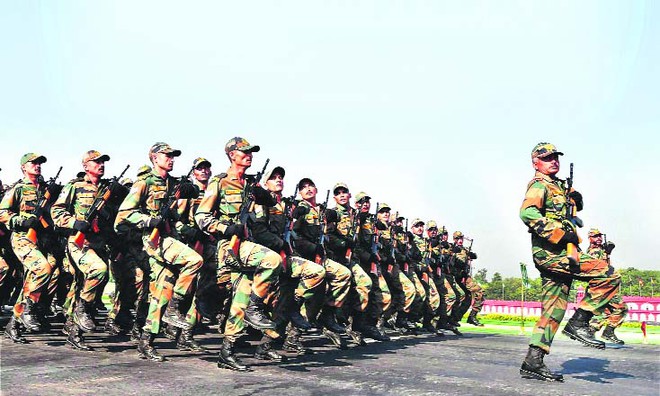
Ever wondered about the plight of the Army’s Infantry soldier! Dressed in battle fatigues, the semi-literate rifle-wielding soldier from a rural or semi-urban part of the country spends much of his career patrolling and guarding disputed borders with China and Pakistan in tough terrains that range from hilly jungles to very high-altitude barren, rocky mountains and glaciers and in extreme weather conditions. For the last 60 years, starting the Infantry soldier has been fighting a bleeding and fatiguing irregular war against terrorists and insurgents. Soldiers have silently suffered hostility, at best, indifference of sections of people in parts of J&K and some states in the northeast. Plus, they have to help in times of natural disasters such as earthquake, floods and landslides.Yet the Infantry’s 382 battalions, which comprise the largest arm of the Army, are also among the most neglected and lacking even in some basic equipment. Lost in the race for acquiring the more glamorous and highly expensive ‘big ticket; items such as tanks, artillery,
surface-to-air missiles, helicopters etc, th e not-so-glamorous Infantryman does not evoke the same level of urgency even though it is the public face of the Army and bears the maximum casualties whether during war or peace. In April 2005 the Army conceived a major modernization plan for the Infantry with the fancy title of F-INSAS (Futuristic Infantry Soldier as a System). The project, spread over three phases and originally scheduled to have begun rolling out in stages from 2012 to 2020, is meant to upgrade, if not altogether revolutionize, the Infantry into an ultra-modern fighting machine. The aim is to provide the soldier with lethality, mobility, survivability, communications and situational awareness. The F-INSAS is based on five major technologies: (i) modular weapons; (ii) body armour and individual equipment; (iii) weapon sights and hand-held target acquisition devices; (iv) communication equipment to enable soldiers to transmit and receive complex voice, data and video systems; and (v) portable computers for soldiers and officers. The ambitious programme has made little progress and compares poorly with the ground realities 11 years after the project was conceived. Let alone modular assault rifles with interchangeable barrels (7.62 mm for counter-insurgency operations and 5.56 mm for conventional warfare), the Army has been unable to replace the existing and flawed 5.56 mm indigenously produced INSAS (Indian Small Arms System) rifle. A global tender floated in 2011 has been cancelled as all the competitors failed to clear the trials. The Infantry needs 1,85,000 new and better assault rifles which continue to remain elusive. But let alone buying new rifles, the Army has been unable to even change the orange colour of the existing INSAS rifles which compromises the camouflage of the soldiers thus putting them to risk.The Infantry presents a microcosm of the existing deficiencies in the Army which includes even basic and non-lethal items. Starting from 1,26,270 mosquito nets, 1,86,092 brown canvas rubber sole shoes with laces and 2,17,388 high-ankle boots, the Infantry is suffering a shortfall of 4,47,000 ski masks (required in the mountains) and three lakh bullet-proof vests, which can help protect the lives of soldiers in counter-insurgency operations and along the Line of Control. There is uncertainty over the current tenders for 44,600 carbines and 4,097 light machine guns that the Infantry is in dire need of even as about 1,000 Infantry combat vehicles need an upgrade. One other ‘small stuff’ is the need to replace the existing thin brown canvas shoes with proper sports shoes. Over 10 years later, the Army continues to await 8 lakh superior quality PT shoes for its troops. The Army is already suffering a woeful shortfall of ammunition including the Armoured Corps, Artillery, Air Defence and Infantry. So severe is the deficiency in ammunition that the Army’s War Wastage Reserve (WWR) has fallen from the required 40 days to between 15 and 20 days. In other words, the Army does not have ammunition enough to fight a war for more than 15-20 days. The depletion of the WWR is partly also because the Army is being forced to divert resources to raise a new Mountain Strike Corps (17 Corps). The first of its kind Mountain Strike Corps, sanctioned in July 2013 and to be raised by 2021, is being established at a cost of Rs 65,000 crore and will add 90,274 more soldiers and 32 new Infantry battalions. This will increase the number of existing Infantry battalions to 414. The WWR is expected to reach 100 percent only in 2019. Owing to delays in the F-INSAS project which has since been restructured and modified, the Infantry is a long way from becoming a fully networked all-terrain, all-weather personal-equipment platform with enhanced firepower and mobility for the digitalized battlefield of the future. The Infantry soldier’s wait has only become longer.
e not-so-glamorous Infantryman does not evoke the same level of urgency even though it is the public face of the Army and bears the maximum casualties whether during war or peace. In April 2005 the Army conceived a major modernization plan for the Infantry with the fancy title of F-INSAS (Futuristic Infantry Soldier as a System). The project, spread over three phases and originally scheduled to have begun rolling out in stages from 2012 to 2020, is meant to upgrade, if not altogether revolutionize, the Infantry into an ultra-modern fighting machine. The aim is to provide the soldier with lethality, mobility, survivability, communications and situational awareness. The F-INSAS is based on five major technologies: (i) modular weapons; (ii) body armour and individual equipment; (iii) weapon sights and hand-held target acquisition devices; (iv) communication equipment to enable soldiers to transmit and receive complex voice, data and video systems; and (v) portable computers for soldiers and officers. The ambitious programme has made little progress and compares poorly with the ground realities 11 years after the project was conceived. Let alone modular assault rifles with interchangeable barrels (7.62 mm for counter-insurgency operations and 5.56 mm for conventional warfare), the Army has been unable to replace the existing and flawed 5.56 mm indigenously produced INSAS (Indian Small Arms System) rifle. A global tender floated in 2011 has been cancelled as all the competitors failed to clear the trials. The Infantry needs 1,85,000 new and better assault rifles which continue to remain elusive. But let alone buying new rifles, the Army has been unable to even change the orange colour of the existing INSAS rifles which compromises the camouflage of the soldiers thus putting them to risk.The Infantry presents a microcosm of the existing deficiencies in the Army which includes even basic and non-lethal items. Starting from 1,26,270 mosquito nets, 1,86,092 brown canvas rubber sole shoes with laces and 2,17,388 high-ankle boots, the Infantry is suffering a shortfall of 4,47,000 ski masks (required in the mountains) and three lakh bullet-proof vests, which can help protect the lives of soldiers in counter-insurgency operations and along the Line of Control. There is uncertainty over the current tenders for 44,600 carbines and 4,097 light machine guns that the Infantry is in dire need of even as about 1,000 Infantry combat vehicles need an upgrade. One other ‘small stuff’ is the need to replace the existing thin brown canvas shoes with proper sports shoes. Over 10 years later, the Army continues to await 8 lakh superior quality PT shoes for its troops. The Army is already suffering a woeful shortfall of ammunition including the Armoured Corps, Artillery, Air Defence and Infantry. So severe is the deficiency in ammunition that the Army’s War Wastage Reserve (WWR) has fallen from the required 40 days to between 15 and 20 days. In other words, the Army does not have ammunition enough to fight a war for more than 15-20 days. The depletion of the WWR is partly also because the Army is being forced to divert resources to raise a new Mountain Strike Corps (17 Corps). The first of its kind Mountain Strike Corps, sanctioned in July 2013 and to be raised by 2021, is being established at a cost of Rs 65,000 crore and will add 90,274 more soldiers and 32 new Infantry battalions. This will increase the number of existing Infantry battalions to 414. The WWR is expected to reach 100 percent only in 2019. Owing to delays in the F-INSAS project which has since been restructured and modified, the Infantry is a long way from becoming a fully networked all-terrain, all-weather personal-equipment platform with enhanced firepower and mobility for the digitalized battlefield of the future. The Infantry soldier’s wait has only become longer.
dkumar@tribunemail.com
